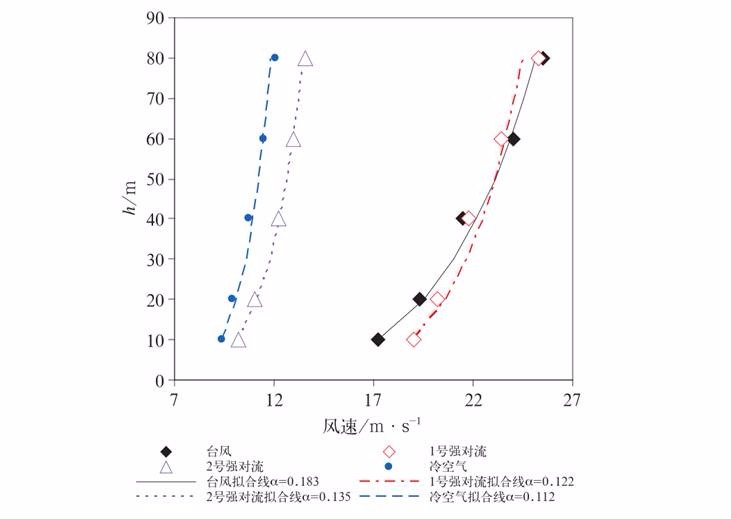本文已被:浏览 1235次 下载 4121次
投稿时间:2017-08-24 修订日期:2018-09-30
投稿时间:2017-08-24 修订日期:2018-09-30
中文摘要: 利用广东省东莞市的80 m气象塔在台风莫拉菲、强对流和强冷空气期间的观测数据,分析不同强风天气系统近地面边界层的平均风和脉动风特性参数。研究发现:(1)1号强对流的风速变化最为剧烈,风速的10 min升幅可分别达台风和强冷空气大风的1.8和3.7倍。强对流的10 min平均风向变幅也最剧烈,可达到120°·(10 min)-1。(2)台风强风廓线的幂指数值为0.177,要大于建筑结构荷载规范(GB 5009—2012)给出的B类下垫面0.15的参考值,而强对流的幂指数值接近规范给出的A类下垫面的参考值0.12,强冷空气的幂指数值则仅为0.10。(3)1号强对流强风平均湍流强度分别是台风和强冷空气大风平均湍流强度的1.4~2.1和1.7~2.0倍。(4)台风和强对流的风攻角在-3°~3°范围内,强冷空气大风的风攻角在0°附近变动。(5)强风影响期间湍流空间积分尺度均有增大的现象,台风强风经过时,水平(纵向和横向)湍流空间积分尺度明显增大了一个量级。(6)台风强风的湍流功率谱不满足在惯性子区湍流能谱密度的-5/3次方与频率成正比的规律和各向同性假设。台风强风的湍流能谱值要显著高于强对流和强冷空气,其中,在桥梁敏感频域台风的平均湍流能谱值约为强对流和强冷空气的3倍。
中文关键词: 台风,强对流,强冷空气,风特性
Abstract:Using the wind data observed from the 80 m meteorological tower in Dongguan of Guangdong Province during the passes of Typhoon Molave, severe convection and severe cold air, the mean wind and fluctuating wind characteristics of different strong wind weather systems in the near surface boundary layer are analyzed. The results show that: (1) the wind speed variation of the severe convection No.1 is most dramatic and the 10 min mean wind speed amplitude of severe convection can go up to 1.8 times and 3.7 times as much as that of typhoon and severe cold air. The 10 min mean wind direction amplitude can be 120°·(10 min)-1. (2) The power law exponent of typhoon strong wind profile is 0.177 which is larger than 0.15 that is recommended as the power law exponent of exposure class B in Chinese National Code (GB 5009-2012). The power law exponent of severe convection is near 0.12 which is recommended as the exposure class A in the code and the power law exponent of severe cold air is only 0.10. (3) The 10 min average turbulence intensity of No.1 severe convection can go up to 1.4-2.1 times and 1.7-2.0 times as much as that of typhoon and severe cold air. (4) The attack angles of typhoon and severe convection change between -3°-3° while the attack angle of severe cold air changes near 0°. (5) The turbulence integral length scales increase due to the impact of strong wind processes. The horizontal (longitudinal and transverse) turbulence integral length scales of typhoon can obviously increase by an order of magnitude. (6) The typhoon strong wind spectra does not satisfy the -5/3 law and the isotropy assumption. The power spectral density (PSD) va lue of typhoon is significantly larger than that of severe convection and severe cold air. The PSD value of typhoon is about 3 times as large as that of severe convection and severe cold air.
文章编号: 中图分类号: 文献标志码:
基金项目:广东省气象局科学技术研究项目(2015B32)、科技部科技基础性工作专项(2013FY112400)和国家自然科学基金青年基金项目(41305007)共同资助
| 作者 | 单位 |
| 陈雯超 | 广东省气象防灾技术服务中心,广州 510080 |
| 刘爱君 | 广东省气象防灾技术服务中心,广州 510080 |
| 宋丽莉 | 中国气象局公共气象服务中心,北京 100081 |
| 王丙兰 | 中国气象局公共气象服务中心,北京 100081 |
引用文本:
陈雯超,刘爱君,宋丽莉,王丙兰,2019.不同强风天气系统风特性的个例分析[J].气象,45(2):251-262.
CHEN Wenchao,LIU Aijun,SONG Lili,WANG Binglan,2019.Case Study of Wind Characteristics of Different Strong Wind Systems[J].Meteor Mon,45(2):251-262.
陈雯超,刘爱君,宋丽莉,王丙兰,2019.不同强风天气系统风特性的个例分析[J].气象,45(2):251-262.
CHEN Wenchao,LIU Aijun,SONG Lili,WANG Binglan,2019.Case Study of Wind Characteristics of Different Strong Wind Systems[J].Meteor Mon,45(2):251-262.


